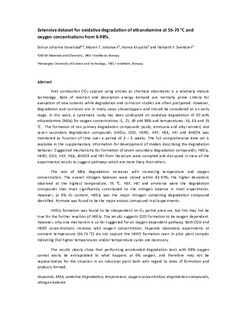| dc.contributor.author | Vevelstad, Solrun Johanne | |
| dc.contributor.author | Johansen, Maren T | |
| dc.contributor.author | Knuutila, Hanna K | |
| dc.contributor.author | Svendsen, Hallvard Fjøsne | |
| dc.date.accessioned | 2017-10-25T08:30:02Z | |
| dc.date.available | 2017-10-25T08:30:02Z | |
| dc.date.created | 2016-05-21T05:49:52Z | |
| dc.date.issued | 2016 | |
| dc.identifier.citation | International Journal of Greenhouse Gas Control. 2016, 50 158-178. | nb_NO |
| dc.identifier.issn | 1750-5836 | |
| dc.identifier.uri | http://hdl.handle.net/11250/2462032 | |
| dc.description.abstract | Post combustion CO2 capture using amines as chemical absorbents is a relatively mature technology. Rate of reaction and desorption energy demand are normally prime criteria for evaluation of new solvents while degradation and corrosion studies are often postponed. However, degradation and corrosion are in many cases showstoppers and should be considered at an early stage. In this work, a systematic study has been conducted on oxidative degradation of 30 wt% ethanolamine (MEA) for oxygen concentrations: 6, 21, 49 and 98% and temperatures: 55, 65 and 75 °C. The formation of ten primary degradation compounds (acids, ammonia and alkyl amines) and seven secondary degradation compounds (HEGly, OZD, HEPO, HEF, HEA, HEI and BHEOX was monitored as function of time over a period of 3–6 weeks. The full comprehensive data set is available in the supplementary information for development of models describing the degradation behavior. Suggested mechanisms for formation of seven secondary degradation compounds; HEGly, HEPO, OZD, HEF, HEA, BHEOX and HEI from literature were compiled and discussed in view of the experimental results to suggest pathways which are more likely than others. The rate of MEA degradation increases with increasing temperature and oxygen concentration. The overall nitrogen balances were closed within 83–97%; the higher deviations observed at the highest temperature, 75 °C. HEF, HEI and ammonia were the degradation compounds that most significantly contributed to the nitrogen balance in most experiments. However, at 6% O2 content, HEGly was the major nitrogen containing degradation compound identified. Formate was found to be the major anionic compound in all experiments. HEGly formation was found to be independent on O2 partial pressure, but this may not be true for the further reaction of HEGly. The results suggests OZD formation to be oxygen dependent. However, only one mechanism is so far suggested for an oxygen dependent pathway. Both OZD and HEPO concentrations increase with oxygen concentration. Separate laboratory experiments at constant temperature (55–75 °C) do not capture the HEPO formation seen in pilot plant samples indicating that higher temperatures and/or temperature cycles are necessary. The results clearly show that performing accelerated degradation tests with 98% oxygen cannot easily be extrapolated to what happens at 6% oxygen, and therefore may not be representative for the situation in an industrial plant both with regard to rates of formation and products formed. | nb_NO |
| dc.language.iso | eng | nb_NO |
| dc.publisher | Elsevier | nb_NO |
| dc.relation.uri | http://www.sciencedirect.com/science/article/pii/S1750583616301803 | |
| dc.title | Extensive dataset for oxidative degradation of ethanolamine at 55-75 °C and oxygen concentrations from 6 to 98% | nb_NO |
| dc.type | Journal article | nb_NO |
| dc.type | Peer reviewed | nb_NO |
| dc.description.version | submittedVersion | nb_NO |
| dc.source.pagenumber | 158-178 | nb_NO |
| dc.source.volume | 50 | nb_NO |
| dc.source.journal | International Journal of Greenhouse Gas Control | nb_NO |
| dc.identifier.doi | 10.1016/j.ijggc.2016.04.013 | |
| dc.identifier.cristin | 1356665 | |
| dc.relation.project | Norges forskningsråd: 189998 | nb_NO |
| dc.description.localcode | This is the authors' manuscript to the article (preprint). | nb_NO |
| cristin.unitcode | 194,66,30,0 | |
| cristin.unitname | Institutt for kjemisk prosessteknologi | |
| cristin.ispublished | true | |
| cristin.fulltext | preprint | |
| cristin.qualitycode | 2 | |
